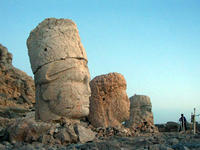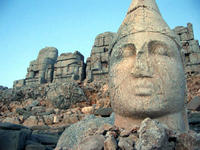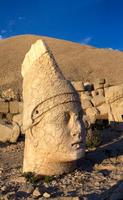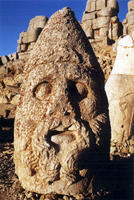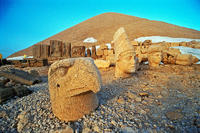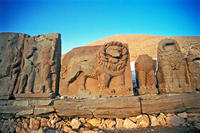You are in: Asia -> Turkey -> Nemrut Dağ, and traditional search or Image Gallery will yield results of this site only
Nemrut Dağ
| Site number: | 448 |
|
| Type of site: | Cultural | |
| Date: | 69–34 B.C. | |
| Date of Inscription: | 1987 | |
| Location: | Eurasia, Turkey, Adiyaman Province | |
Up to 75 images are shown here. Click on each for more details or on Image Gallery for more images.
| Description: | Antiochus I (69–34 B.C.) governed Commagene, a kingdom founded after the breakup of Alexander's empire north of Syria and the Euphrates, his mausoleum is one of the Hellenistic period’s most ambitious constructions. As a testimony to this kingdom's dual cultural origins is the conjunction of its pantheon, and the lineage of its kings, which can be traced back through two, both Greek and Persian, sets of legends. --WHMNet paraphrase from the description at WHC Site, where additional information is available. | |
| Nemrut or Nemrud (Turkish: Nemrut Dağ or Nemrut Dağı, Kurdish: Çiyayê Nemrûd, Armenian: Նեմրութ Սար) is a 2,134 meters (7000 ft.) high mountain in eastern Turkey, 40km north of Kahta, near Adıyaman. At the top of Mt. Nemrut, King Antiochus I Theos of Commagene built his tomb-sanctuary along with huge statues (8-9 meters high) of himself, two lions and two eagles, and various Greek and Persian gods such as Hercules, Zeus-Oromasdes (associated with the Persian god Ahura Mazda), Tyche, and Apollo-Mithras in 62 BC. These statues were once seated, with names of each god inscribed on them. The heads of the statues are scattered throughout the site; the pattern of damage to the heads (notably to noses) suggests iconoclasm. There are stone slabs, with bas-relief figures on them, that are thought to have formed a large frieze. These stones display the ancestors of Antiochus, who were Macedonians and Persians both. This tomb contains stone carvings of gods, such as the head of an eagle. --Wikipedia. Text is available under the Creative Commons Attribution-ShareAlike License. | ||
| Source: | http://whc.unesco.org/en/list/448 | |
| Reference: | 1. UNESCO World Heritage Center, Site Page. | |







